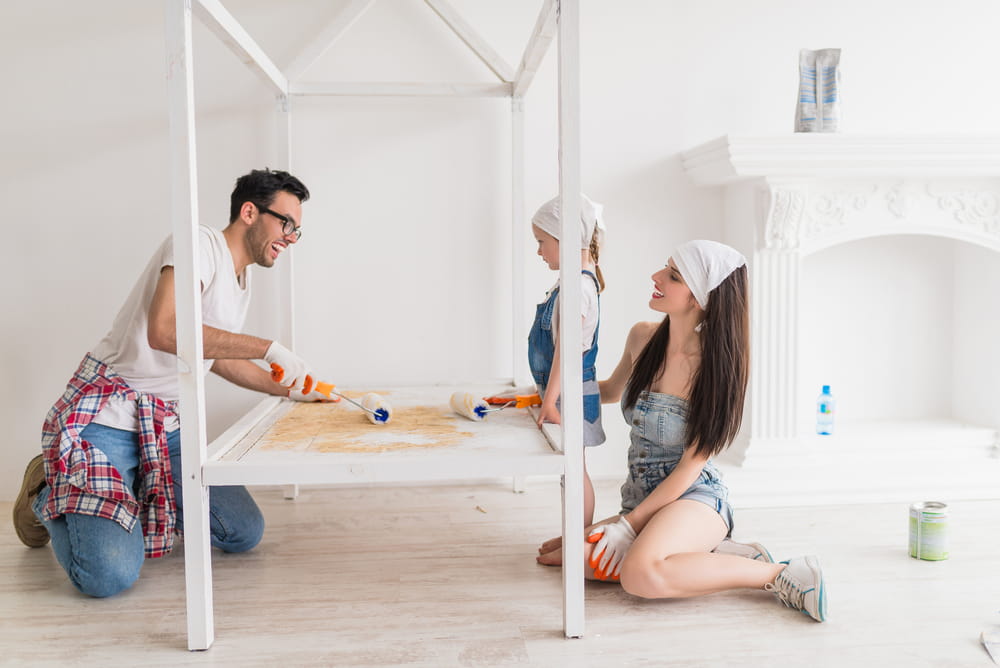As the name suggests, “prehabbing” represents the convergence of two of the industry’s most prominent real estate exit strategies: the wholesale deal and the almighty rehab. However, a prehab is much more the result of its own niche than a duplicate knockoff. Investors of every level have come to rely on real estate prehabs as one of the most viable real estate exit strategies; one that can be depended on when the time calls for it.
Having said that, what is a real estate prehab? Should every investor familiarize himself or herself with the concept of prehabbing real estate? Perhaps even more importantly, how can prehabbing bring your real estate career to the next level? Find the answers to all these questions and more below!
[ Thinking about investing in real estate? Register to attend a FREE online real estate class and learn how to get started investing in real estate. ]

What Is Real Estate Prehabbing?
In its purest sense, prehabbing is clearing the slate for rehabbers that will buy and hold investment properties as rentals. It can make properties easier and more appealing for the end buyer. In turn, this helps increase perceived value and can help flip houses much faster. Real estate house flippers can use prehabbing, as outlined above, to find a middle ground between wholesaling properties as-is and full rehabs. For some, this can dramatically increase the attractiveness of a property while broadening the buyer pool. In some cases, this light rehabbing can take a rundown property from unlivable to actually being both functional and attractive to a potential buyer.
Prehabbing Vs. Flipping Vs. Wholesaling
In order to better understand the concept of prehabbing homes, let us first discern how it differentiates itself from its better-known counterparts.
Rehabbing, otherwise known as house flipping, has taken the country by storm and is currently entrenched as the most popular real estate exit strategy to date. If the terms sound familiar, it is because they are; there is a good chance you have seen one of the many television shows covering real estate investors flipping properties.
In its simplest form, rehabbing witnesses the investor acquire a property with the intentions of selling it for a profit at a later date. Consequently, said profit is either the direct result of improvements made to the property and — if they are lucky — appreciation. In the end, the right improvements should provide the investor with an opportunity to sell the home for more than the combined cost of the original purchase price and the amount of money they spent improving it.
Wholesaling, on the other hand, doesn’t require nearly as much time and no repairs are needed to complete a wholesale deal. According to Investopedia, “a real estate wholesaler contracts with a home seller, markets the home to his potential buyers, and then assigns the contract to the buyer. The wholesaler makes a profit serving as the middle-man in a deal between a seller and another investor, which is the difference between the contracted price with the seller and the amount paid by the buyer.”
How Does Prehabbing Work?
Real estate prehabbing has essentially borrowed aspects from wholesaling and rehabbing, and combined them into one simple exit strategy; it is a hybrid combination of the two. Let me explain:
Not unlike a rehab deal, any attempt to prehab a property starts with the acquisition; you are going to buy a property with the intentions of selling it for more at a future date. However, your buyers list will not consist of someone looking to live in a finished product, but rather a rehabber who will take on the property, fix it up, and then sell it again; this time to an end-buyer. As the prehabber, you are merely the middleman between a seller and a subsequent investor; hence the wholesale part.
Unlike a wholesale deal, you are actually taking control of the property, which gives you the ability to make slight changes. The modifications you decide to make, however, are nowhere near as extensive as your average rehab. In fact, your main prerogative as a prehabber is not to rehab the property at all, but to fix it up just enough so that a rehabber will want to take it on as their next project. Highlight the property’s potential and enable others to see it for what its worth.
Chances are a little landscaping and some floor polish will go a long way in persuading a rehabber to take a chance on the property. Remember, it is entirely possible to prehab a property by doing nothing more than picking up trash. As long as what you do makes the home more attractive to potential investors, you have done your job.
What Does Prehabbing Involve?
How much improvement work should be involved or not? What focus and principles can keep real estate investors on the right track here? Perhaps the best way to look at prehabbing and to make it work is to look at it as:
-
Maximizing the value and profit of a real estate investment opportunity
-
Keeping improvements, risk, and time involved to a minimum
The primary reason many engage in prehabbing is that many prospective end buyers simply can’t see the potential or perceive more work and expense than maybe there. Many discounted homes being picked up by wholesalers today can look in pretty bad shape. Clearing up the cosmetic appearance can make a world of difference in the value of a property to an end buyer whether they are going to live in it, rehab and resell it or stick a renter in it.
At the same time, many rehabbers may choose to scale back to prehabbing to limit the amount of cash they tie up in a single property, and avoid getting caught up in gut rehabs that can uncover or create more expensive. So, in many cases, this might just be clearing the slate by hauling out the trash, cleaning up the yard and perhaps making a few minor cosmetic patches.
On the other hand, many properties may just need a few minor upgrades. For example; replacing a couple of appliances, changing stained carpet or a new interior paint job. Obviously, a landlord ought to be willing to pay more and be faster to act on an investment opportunity that is ready to lease immediately than one which they have to begin working on and may not know what issues lay beneath the mounds of garbage.

10 Advantages Of Prehabbing
At the end of the day, a good prehab deal is merely a cosmetic fix-up that will make you money, with little to no additional cost. While finding a distressed property with just enough upside in terms of potential and price isn’t easy, done right it can yield a sizeable profit for beginner investors. According to Than Merrill, the top 10 reasons to get started in prehabbing include:
-
For flipping houses faster
-
Faster turns enabled more homes to be flipped each month and year
-
Raising monthly, annual and lifetime income and returns
-
Maximizing return on investment
-
Maximizing return on property improvements
-
Selling properties for more money
-
Shortening time from acquisition to having a marketable product
-
Reducing cash needed for improvements
-
Lowering risk associated with tying up capital and gut rehabs
-
Minimizing management requirements
For beginner real estate investors, the benefits of prehabbing are enormous. Along with limiting the amount of cash you tie up in a single property, prehabbing is simply tied to the amount of sweat equity you want to invest, making it a win-win for you, the investor.
The allure of prehabbing is easy to see: low risk, little work and a quick return on investment (ROI). While not every property is best suited for a prehab, it is something to consider, especially when you run across a property that is a complete disaster. Understanding how to spot a potential prehab deal, as well as being aware what the risks and rewards of prehabbing will only ensure your success continues in real estate investment.
How To Prehab A Property
A proper prehab is contingent on one thing: providing prospective buyers with a clean slate. Your sole priority, for that matter, is to have the foresight that others may be lacking. It is absolutely critical that you are able to see a property for what it can be. You must therefore be able to discern what others can’t. It is on you to show them that the home is worth their time.
All you need to do is create a vision for prospective buyers; no more and no less. Any work you do on the property, for that matter, should be contingent on unlocking its potential. By no means do you need make significant or drastic changes; simply allow other buyers to see the potential you saw when you first put the home under contract.
The moment you invest too much time and money into a prehab, you will blur the line separating it from a rehab. If it is a rehab you are looking for, consult our rehabbing checklist. But remember, it’s not your job to fix the entire property, but rather prepare it to be fixed by someone else.
However, there are prehab improvements that have become synonymous with better returns than others. While each property will require its own unique strategy, let’s take a look at the universal improvements I recommend implementing on your next prehab deal:
1. Paint
Nothing that I am aware of has the same impact on a property’s “appeal” with a relatively minimal investment than a new paint job. If for nothing else, a fresh coat of paint has a way of freshening up the entire home. You would be surprised at how much better a home can look with a few buckets of paint and some sweat equity.
2. Clean The Floors
Whether your prehab consists of hardwood floors, tile or carpet, chances are it could use a little refreshing. By no means should you replace what is already in the home, but do your best to make it presentable. Feel free to clean the carpets and polish any hardwood floors. If for nothing else, the negative impression poorly maintained floors can give off is enough to scare away potential suitors from your property. Don’t let a small oversight such as this prevent you from landing the investor you need to make a profit.
3. Let There Be Light
I highly encourage anyone conducting a prehab to introduce as much light into the property as possible. For starters, I recommend taking down any blinds or drapes that may be serving as an obstruction; chances are they will be removed when the real rehabbing takes place. Subsequently, take some time to clean the glass, both inside and out. It is a small gesture, but can pay huge dividends.
4. General Cleaning
I would be remiss if I didn’t at least mention getting a little dirty. Dedicate some time to cleaning the little things; the devil is in the details. Take some bleach to the bathrooms and make the toilet, sink, and shower shine like new. Clean the grout between the kitchen tiles. Above all, get rid of any unwanted clutter or debris. Leave no stone unturned. The cleaner your property is, the more attractive it will be to a potential buyer.
5. Landscaping
Landscaping may be the most important item on this list. That said, nothing has the potential to increase your home’s curb appeal quite like a little yard maintenance. Add some new mulch to the flowerbed or simply cut the grass. Anything to make the front yard more presentable will make a world of difference when investors view the property.

Summary
If my years as a real estate investor have taught me one thing, it’s that you never go into a deal without having a backup plan. Wholesales and rehabs are alive and well, but not necessarily always your best option. Prehabbing, on the other hand, is a great alternative, especially when investing in real estate for beginners. They combine the speed and efficiency of a wholesale deal with the higher profit margins that have become synonymous with rehabs, though not quite as high. In other words, prehabbing homes is a great way to minimize your time commitment and risk while still turning a profit.
Ready to start taking advantage of the current opportunities in the real estate market?
Click the banner below to take a 90-minute online training class and get started learning how to invest in today’s real estate market!

